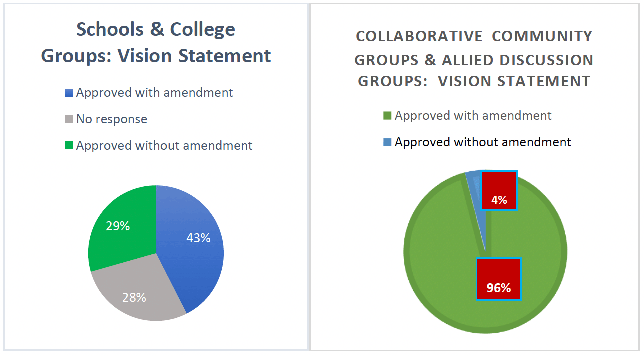Education - Independent Review of Qualifications and Assessment: data analysis – phase 1
Findings from the first phase of the Review consultation on the draft vision and principles.
Methodology and Findings
A total of 408 responses were received via 12 Collaborative Community Groups (CCGs) and 13 allied discussion groups. There are many more responses than there are Collaborative Community Groups because some Collaborative Community Groups provided multiple comments.
The Collaborative Community Groups and allied discussion groups were not asked to record the total number of people involved in their response(s). The number of participants involved in each of the Collaborative Community Groups and allied discussion groups varied. For example, some groups had around six participants others had upwards of 30. Additionally, many IRG members also asked their Collaborative Community Groups members to speak with other members of their extended community before attending the discussion, and to come to their discussion with the views of their wider community in mind. It is therefore not possible to say exactly how many individuals have been involved.
A total of 221 responses were received from the Schools & Colleges survey. Many of these responses involved schools and colleges holding group discussions with multiple teachers/lecturers and learners and these responses were submitted on behalf of the group. The survey included a question asking respondents to list those involved. However, most respondents did not answer this. It is, therefore, not possible to determine exactly how many individuals were involved.
- Quantitative and Qualitative Data Analysis: The quantitative data were subjected to statistical analysis, and qualitative data were explored thematically through matrices. During the qualitative analysis, the extent and richness of the participant's responses was clear despite there not being a dichotomous question in the CCG survey asking respondents to state whether they 'agreed' or 'disagreed' with the vision Statement and each Principle. Participants were keen to share their opinions and beliefs based on each statement. The recommendations and suggestions received indicated agreement or support with amendments in order to improve the statements. Also, some participants provided limited comments in their response.
- The participant's responses were explored in depth through a design that helped to group their responses under a measurement level scale (ordinal variables) to analyse their perceptions about the vision Statement and Principles for Scotland. Three categories were developed to group the participant's responses:
- 1. 'Approved with amendment' describes positive responses with comments about changing or adding some words or phrases.
- 2. 'No response' illustrates an absence of a response.
- 3. 'Approved without amendment' represents only affirmative words and positive answers about the vision and principles.
- Results: The current analysis process of the transcripts elicited key concepts evident in the data. The evidence emerging from the analysis is presented below.
A. Vision statement: The draft version of the vision statement is presented in the box below.
Qualifications and Assessments in Scotland should reflect what matters in the curriculum, recognise every learner's achievements and provide evidence to inspire the next steps in their learning journey. This Vision for the Future of Qualifications and Assessment in Scotland will:
- Recognise the diversity of achievements of every individual learner;
- Provide a solid foundation to the future for all learners, that will support the next step in their life journey be that in employment, further education, higher education, or through other contributions to society; for example, volunteering
- Promote a wide-range of opportunities that meet the needs of all learners;
- Recognise the rights of children, encourage well-being and support the lifelong development of citizens, creating a positive future for Scotland and the wider world; and
- Be recognised and valued by all learners, schools, colleges, universities, employers and by society generally.
Do respondents support the vision statement?
There was little challenge to the fundamental ideas in the vision statement. However, there were a significant number of suggestions to alter the language or to include additional ideas. 96% of responses from the Collaborative Communities, and allied discussion groups, and 71% of Schools & Colleges Groups supported the vision statement with amendments. However, only 4% of Collaborative Community Groups and allied discussion groups and 29% of Schools & Colleges Groups approved the vision statement without amendment. 28% of the Schools & Colleges Groups did not respond to this statement.

Contact
Email: Frank.Creamer@gov.scot
There is a problem
Thanks for your feedback